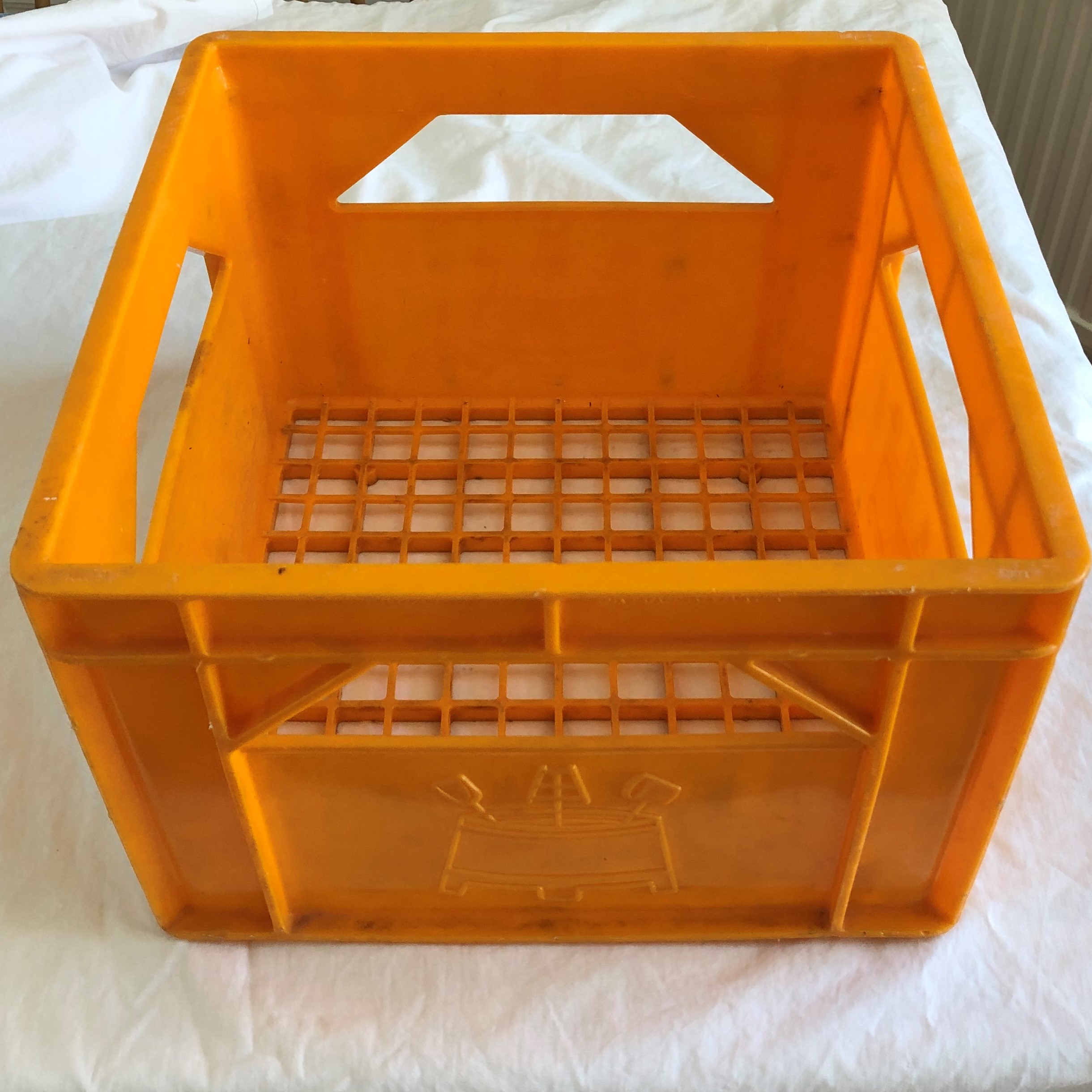 Take a close look at the beverage crate on the left. This unglamorous crate is probably the most common place to store vinyl records. At least in Sweden. The crate on the picture is the classic 25-bottle quadratic model without partition (5*5). There are many of them out there, mostly in yellow but also in dark green. The model was taken out of circulation in the 1980s and replaced by the more ergonomic 20-bottle crates with partition (4*5). You have to take care of your vinyls and cds. Many people treat their vinyls and cds very carelessly. In my opinion, some people aren't equal to the task. Neglect and abuse of vinyls and cds should fall under mandatory reporting. A beverage crate doesn't signal respect for the product or the work behind. Lack of respect is universal. Respect is earned and not given. One who really deserves respect is the German company Protected.de who specializes in products for record collectors. They have virtually everything when it comes to cleaning, protecting and storing vinyls and cds. Their product catalogue is vast and the price level is moderate. A couple of years ago I bought their LP shipping box #1 1-3 LPs (article no 1051) with DHL shipping directly to my front door for €39,85 EUR ($45). A real bargain for 50 cardboard boxes of top quality. If you double-click on their logo below you will be directed to their impressing website (opens in a new window). Even window shopping is a delight with opulent displays of their wares.
Take a close look at the beverage crate on the left. This unglamorous crate is probably the most common place to store vinyl records. At least in Sweden. The crate on the picture is the classic 25-bottle quadratic model without partition (5*5). There are many of them out there, mostly in yellow but also in dark green. The model was taken out of circulation in the 1980s and replaced by the more ergonomic 20-bottle crates with partition (4*5). You have to take care of your vinyls and cds. Many people treat their vinyls and cds very carelessly. In my opinion, some people aren't equal to the task. Neglect and abuse of vinyls and cds should fall under mandatory reporting. A beverage crate doesn't signal respect for the product or the work behind. Lack of respect is universal. Respect is earned and not given. One who really deserves respect is the German company Protected.de who specializes in products for record collectors. They have virtually everything when it comes to cleaning, protecting and storing vinyls and cds. Their product catalogue is vast and the price level is moderate. A couple of years ago I bought their LP shipping box #1 1-3 LPs (article no 1051) with DHL shipping directly to my front door for €39,85 EUR ($45). A real bargain for 50 cardboard boxes of top quality. If you double-click on their logo below you will be directed to their impressing website (opens in a new window). Even window shopping is a delight with opulent displays of their wares. 
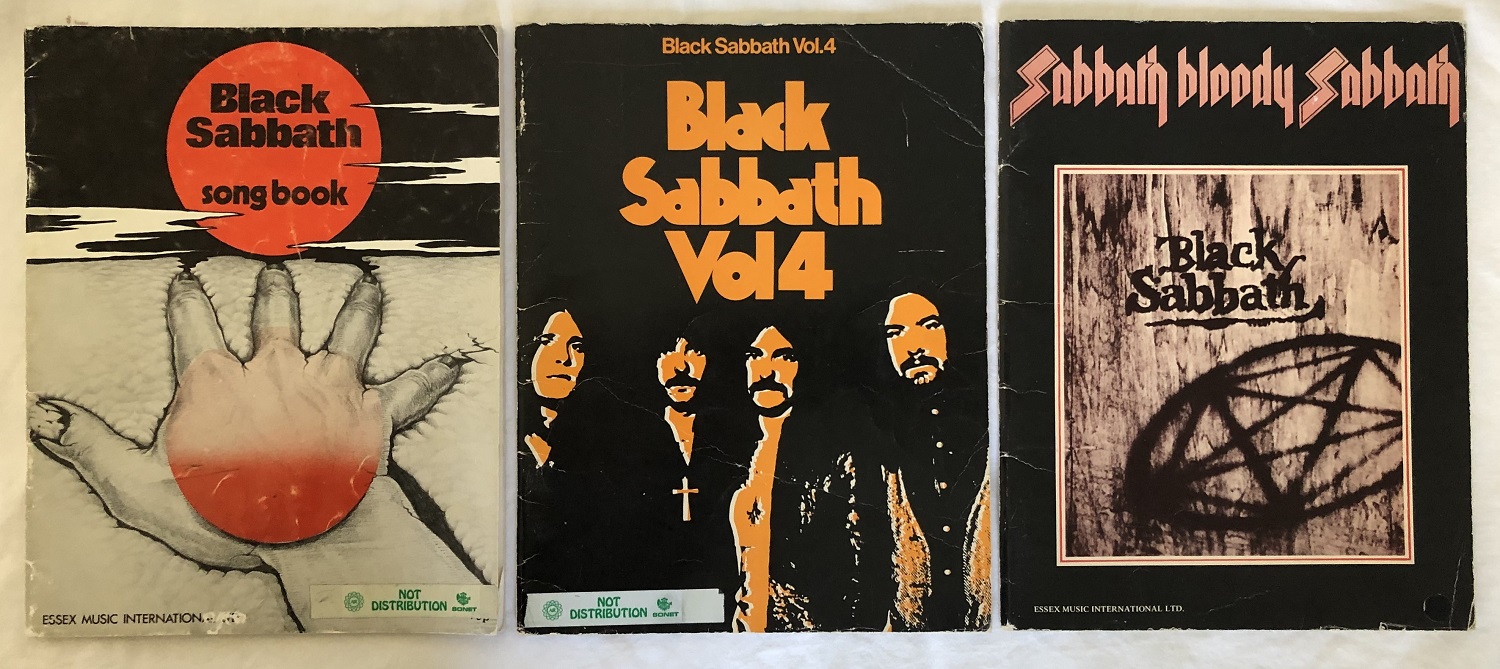 Recently, I got rid of very precious artefacts, namely three booklets with sheet music from Black Sabbaths first five albums. They have been stored in my closets for over 40 years. I read somewhere that if you haven't touched your belongings during the course of three removals, it's safe to get rid of them. Of course, the booklets didn't pass the "three strikes and then you are out"-test. I've moved eight times since I bought them and the last time I moved was 10 years ago. I’m not a hoarder. I haven't collected things other than cds (and stamps when I was very young). Still, your belongings tend to become more and more. The long and hard separation process pushes a lot of buttons. Why did I get them, why did I keep them and what made me finally get rid of them after all these years. In this blog entry I will try my very best to answer these questions. Anyway, we will have to start from the very beginning.
Recently, I got rid of very precious artefacts, namely three booklets with sheet music from Black Sabbaths first five albums. They have been stored in my closets for over 40 years. I read somewhere that if you haven't touched your belongings during the course of three removals, it's safe to get rid of them. Of course, the booklets didn't pass the "three strikes and then you are out"-test. I've moved eight times since I bought them and the last time I moved was 10 years ago. I’m not a hoarder. I haven't collected things other than cds (and stamps when I was very young). Still, your belongings tend to become more and more. The long and hard separation process pushes a lot of buttons. Why did I get them, why did I keep them and what made me finally get rid of them after all these years. In this blog entry I will try my very best to answer these questions. Anyway, we will have to start from the very beginning.
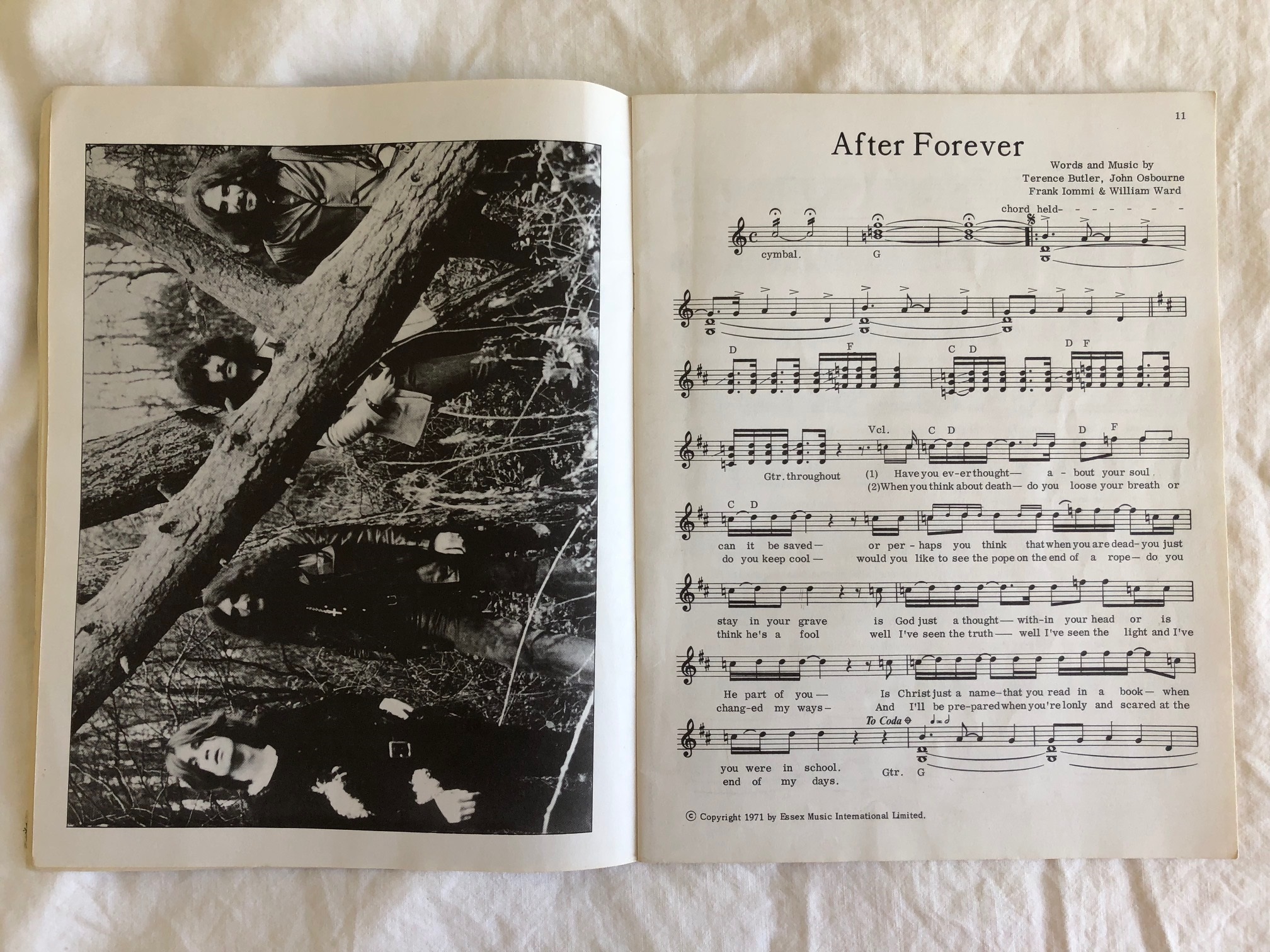 Why did I get them? Very good question. Buying their albums is uncontroversial, but buying their sheet music is more difficult to explain. Anyway, a line had been crossed. In my adolescent years I was a devout Black Sabbath fan. More than devout, I would say. I listened to their albums on maximum volume with the risk of impairment of hearing. However, I never got the chance to see them live (in their haydays, that is). The closest I came to this maybe life-changing experience was a cancelled tour. Allegedly, Ozzy Osbourne was taken in to a mental institution after drug related problems. The first and only time I've seen them live was 3rd of July 2005 at Globen Arena in Stockholm. Original line-up. They did their best to live up to the expectations, but obviously they had passed their expiration date. Rock is a very physical act, especially if you're a drummer. Bill Ward was, at the time, 57 years old. I can imagine how that feels. Back to the devoutness. I bought the booklets with sheet music under the pretense that I should learn to play guitar and master all the Iommi riffs. I didn't succeed. First, I wasn't good at reading music or taking chords. Second, I totally lacked the necessary predisposition and dedication. However, my little brother had both. I was quickly overtaken. Browsing through the booklets brings back memories. I still remember when and where I bought them. I bought them in the mid 1970s at Sergel Musik AB and Svala & Söderlund in Stockholm, small sheet music and record shops (the former an affiliate to the latter). The shops closed down in the beginning of the 1990s and in the year 2000, respectively.
Why did I get them? Very good question. Buying their albums is uncontroversial, but buying their sheet music is more difficult to explain. Anyway, a line had been crossed. In my adolescent years I was a devout Black Sabbath fan. More than devout, I would say. I listened to their albums on maximum volume with the risk of impairment of hearing. However, I never got the chance to see them live (in their haydays, that is). The closest I came to this maybe life-changing experience was a cancelled tour. Allegedly, Ozzy Osbourne was taken in to a mental institution after drug related problems. The first and only time I've seen them live was 3rd of July 2005 at Globen Arena in Stockholm. Original line-up. They did their best to live up to the expectations, but obviously they had passed their expiration date. Rock is a very physical act, especially if you're a drummer. Bill Ward was, at the time, 57 years old. I can imagine how that feels. Back to the devoutness. I bought the booklets with sheet music under the pretense that I should learn to play guitar and master all the Iommi riffs. I didn't succeed. First, I wasn't good at reading music or taking chords. Second, I totally lacked the necessary predisposition and dedication. However, my little brother had both. I was quickly overtaken. Browsing through the booklets brings back memories. I still remember when and where I bought them. I bought them in the mid 1970s at Sergel Musik AB and Svala & Söderlund in Stockholm, small sheet music and record shops (the former an affiliate to the latter). The shops closed down in the beginning of the 1990s and in the year 2000, respectively.
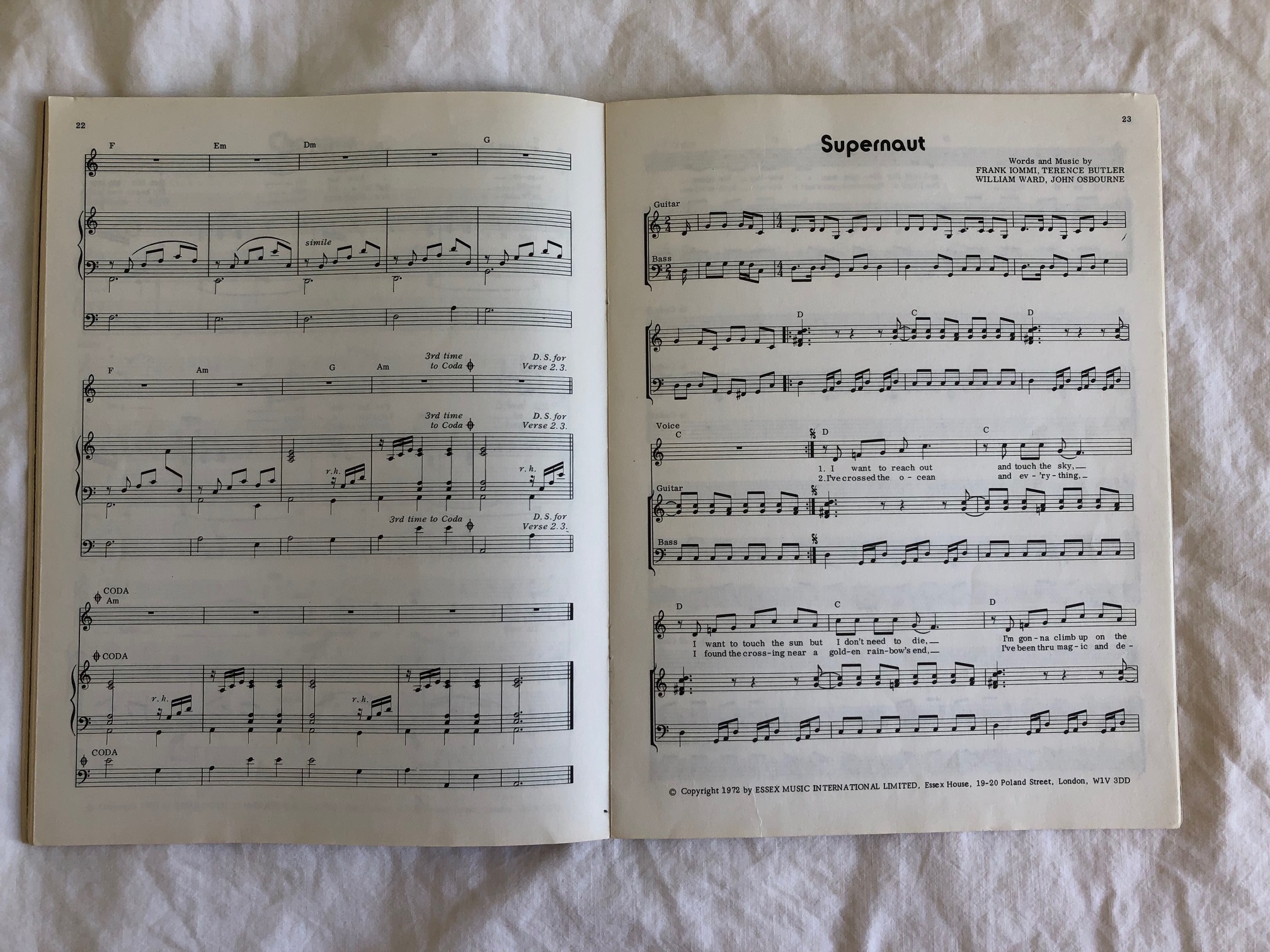 Why did I keep them? I had every reason to get rid of them. In the beginning of the 1980s I adopted a preppy style. It may be hard to imagine, but during my senior year in high school I walked around in pea coat, crew neck Alan Paine cardigan, Lacoste tennis shirt, Dexter loafers and wore checkered golf pants. It wasn't compatible to be associated with Black Sabbath. An awful lot of terrible music rolled in and over us. Black Sabbath were not dead for me. Now and then I listened to them in solitude. Some old classmates were hard core to the bone. At the 2005 concert I met two hardliners, even more devout than I was, who have held on their principles over the years. Never sold out or cut their hair. They weren't surprised to find me there. In some ways it was like coming home again. With age comes that you aren't ashamed for what you are or have been. I think I kept the booklets of the utmost respect for Black Sabbath and a subconscious feeling that we would reconnect later in life. Which we did. And listening to gothic country music today would surely not been possible if it weren't for Black Sabbath. Black is black.
Why did I keep them? I had every reason to get rid of them. In the beginning of the 1980s I adopted a preppy style. It may be hard to imagine, but during my senior year in high school I walked around in pea coat, crew neck Alan Paine cardigan, Lacoste tennis shirt, Dexter loafers and wore checkered golf pants. It wasn't compatible to be associated with Black Sabbath. An awful lot of terrible music rolled in and over us. Black Sabbath were not dead for me. Now and then I listened to them in solitude. Some old classmates were hard core to the bone. At the 2005 concert I met two hardliners, even more devout than I was, who have held on their principles over the years. Never sold out or cut their hair. They weren't surprised to find me there. In some ways it was like coming home again. With age comes that you aren't ashamed for what you are or have been. I think I kept the booklets of the utmost respect for Black Sabbath and a subconscious feeling that we would reconnect later in life. Which we did. And listening to gothic country music today would surely not been possible if it weren't for Black Sabbath. Black is black.
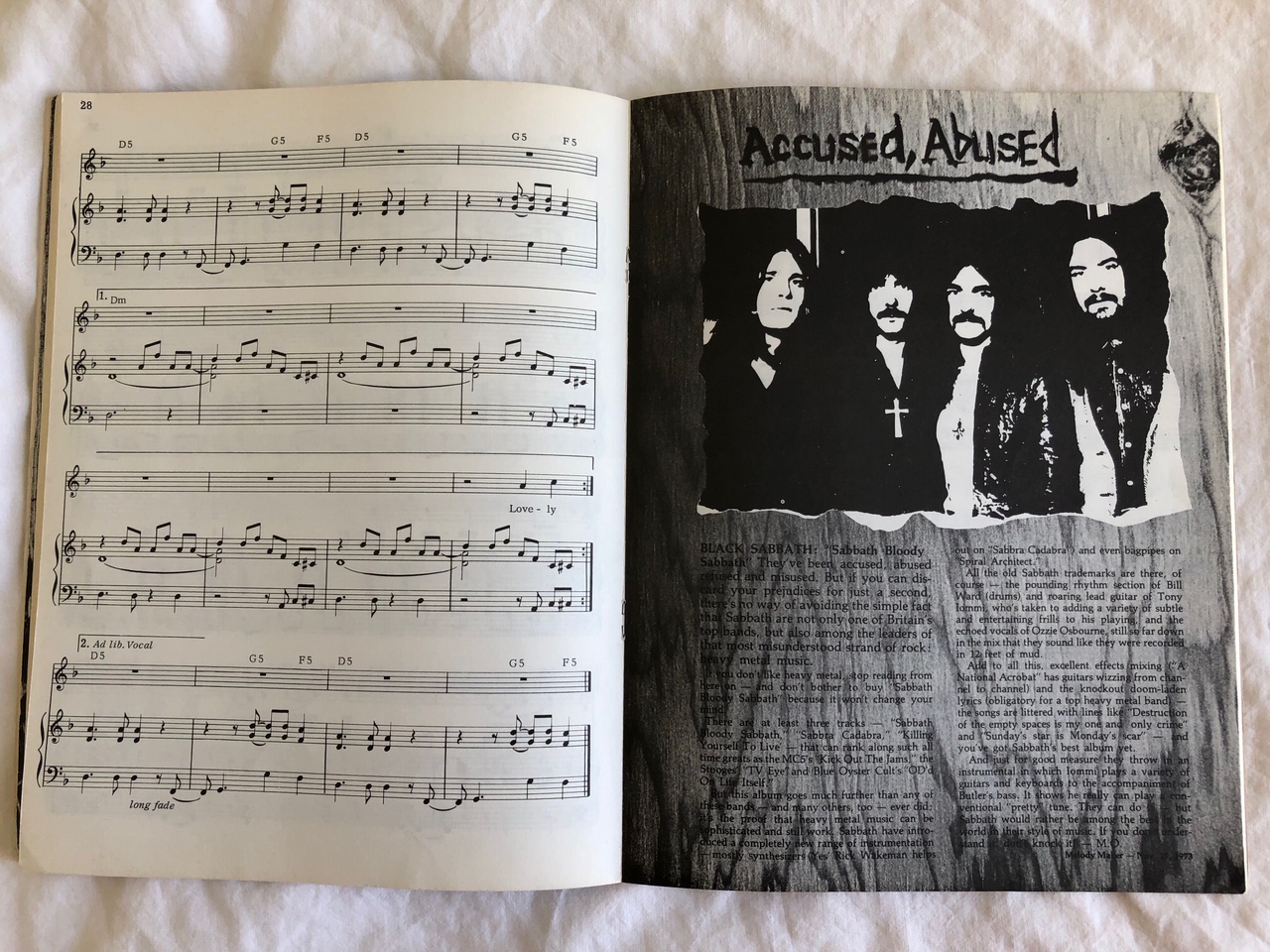 What made me finally get rid of them after all these years? It could be "death cleaning", the Swedish folkloristic phenomenon by which the elderly and their families set their affairs in order. They didn't want to burden their children with going through their drawers, sorting out precious heirlooms from junk. The modern take of the agrarian society phenomenon is when you're downsizing from a house to a smaller apartment. Things go either to a thrift store or in a dumpster. Some people I know set up a strict policy, one in-one out, to keep the total number of things from growing. Maybe there's a simplier explanation to why I got rid of them. You can feel satisfaction over that things comes to use and finds a better home. Now that they're gone I don't feel any remorse or particular empty inside. Sometimes, you have to bend up your cramping fingers and let go of things. Besides, I got 1000 SEK (which is approximately $107) on Tradera (Swedish eBay). This money will go directly into buying rare gothic country cds. I'm not committed to the one in-one out policy. But hopefully, the net effect will be zero. I can also live with a positive net.
What made me finally get rid of them after all these years? It could be "death cleaning", the Swedish folkloristic phenomenon by which the elderly and their families set their affairs in order. They didn't want to burden their children with going through their drawers, sorting out precious heirlooms from junk. The modern take of the agrarian society phenomenon is when you're downsizing from a house to a smaller apartment. Things go either to a thrift store or in a dumpster. Some people I know set up a strict policy, one in-one out, to keep the total number of things from growing. Maybe there's a simplier explanation to why I got rid of them. You can feel satisfaction over that things comes to use and finds a better home. Now that they're gone I don't feel any remorse or particular empty inside. Sometimes, you have to bend up your cramping fingers and let go of things. Besides, I got 1000 SEK (which is approximately $107) on Tradera (Swedish eBay). This money will go directly into buying rare gothic country cds. I'm not committed to the one in-one out policy. But hopefully, the net effect will be zero. I can also live with a positive net.
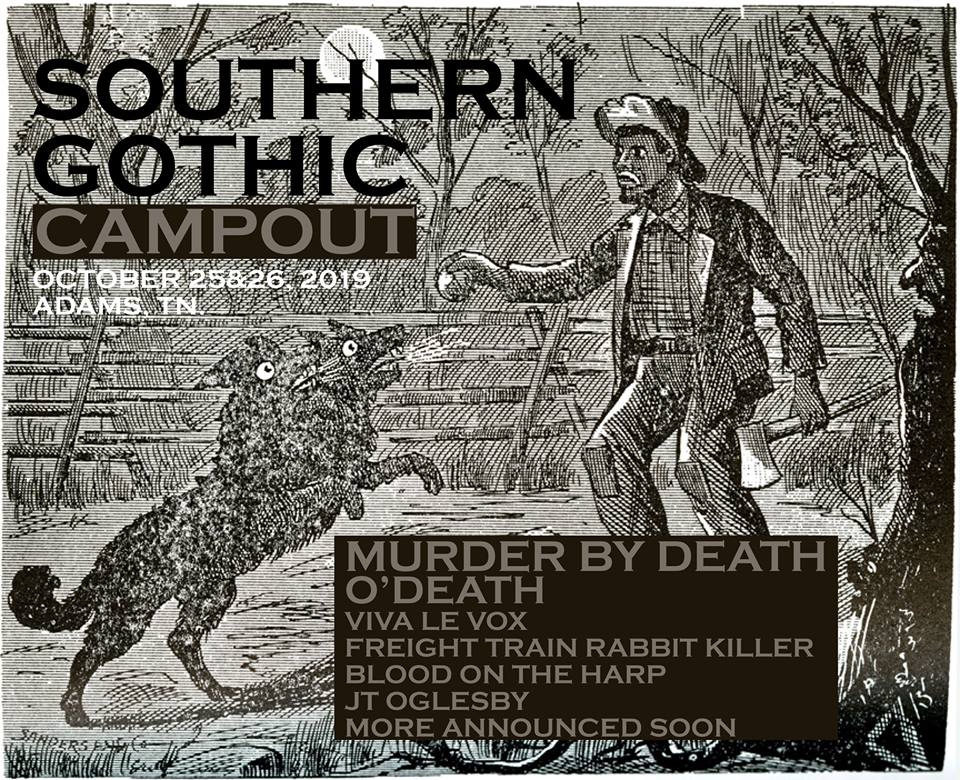 Once is an incident, twice is a trend, thrice is a tradition. Southern Gothic Campout (SGC) is a trend, but hopefully it will turn into a tradition. The dark roots music festival will as before take place in the middle of nowhere in Adams, TN and near the home of the Bell Witch. SGC will surely not beat the Woodstock festival in 1969, which unexpectedly attracted an audience of more than 400 000 people. There's a number of reasons for this prognosis. The most important reason is that tickets are limited to 300. The attendance figure in 2017 was approximately 100. What can I say, the genre attracts a small but dedicated audience. Reportedly it was freezing and pretty remote. Among the bands that performed in 2017 were no less than Those Poor Bastards (evil doom country) and Sons of Perdition (apocalyptic doom country). These bands both fit the "Southern Gothic" bill. But, what about the rest of the bands and artists? The term "Southern Gothic" seems like a misnomer. According to a primary source there were probably three or four acts that could be filed as gothic. And this isn't just the purist point of view. It's an objective fact. The gothic factor seems to be constant this year. But we shouldn't let the best become the enemy of the good. SGC is a great initiative. The main attractions and the bands with the largest fonts on the poster are Murder By Death and O'Death. Other bands are Viva Le Vox, Freight Train Rabbit Killer, Blood on the Harp and JT Oglesby. More bands are to be announced. This event sounds like a lot of fun. But, I will stay home and read about it instead. There's a number of reasons for this damper decision. One reason is that Swedes generally are strangers to camping in late October.
Once is an incident, twice is a trend, thrice is a tradition. Southern Gothic Campout (SGC) is a trend, but hopefully it will turn into a tradition. The dark roots music festival will as before take place in the middle of nowhere in Adams, TN and near the home of the Bell Witch. SGC will surely not beat the Woodstock festival in 1969, which unexpectedly attracted an audience of more than 400 000 people. There's a number of reasons for this prognosis. The most important reason is that tickets are limited to 300. The attendance figure in 2017 was approximately 100. What can I say, the genre attracts a small but dedicated audience. Reportedly it was freezing and pretty remote. Among the bands that performed in 2017 were no less than Those Poor Bastards (evil doom country) and Sons of Perdition (apocalyptic doom country). These bands both fit the "Southern Gothic" bill. But, what about the rest of the bands and artists? The term "Southern Gothic" seems like a misnomer. According to a primary source there were probably three or four acts that could be filed as gothic. And this isn't just the purist point of view. It's an objective fact. The gothic factor seems to be constant this year. But we shouldn't let the best become the enemy of the good. SGC is a great initiative. The main attractions and the bands with the largest fonts on the poster are Murder By Death and O'Death. Other bands are Viva Le Vox, Freight Train Rabbit Killer, Blood on the Harp and JT Oglesby. More bands are to be announced. This event sounds like a lot of fun. But, I will stay home and read about it instead. There's a number of reasons for this damper decision. One reason is that Swedes generally are strangers to camping in late October.
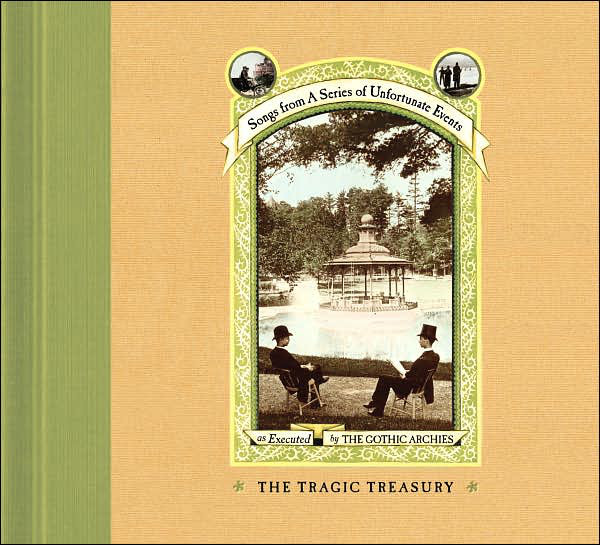 I'm surprised, thrilled and amused. I thought that I had explored every single branch, twig and leaf in the gothic country music genre. Obviously, I had overlooked "goth-bubblegum". The finest and maybe only example of this sub-genre is "The Gothic Archies" (TGA). The band name is a pun, alluding to the term "Gothic arch" and to the fictional garage band "The Archies". A little bit of humour in the gothic genre won't kill us. TGA was created and largely performed by Stephin Merritt of The Magnetic Fields (indie-pop). TGA got more well-known when Merritt wrote, performed and recorded songs for the audiobook versions of Lemony Snicket's "A Series of Unfortunate Events". For those of you who aren't familiar to this book series, it's Victorian gothic literature for children disguised as children's novels. A collection of thirteen songs based on each book and two additional tracks was released as "The Tragic Treasury" on October 10, 2006, to coincide with the release of the final book in the series. The main thirteen books in the series have collectively sold more than 60 million copies and have been translated into 41 languages. The Gothic Archies briefly toured to promote the album featuring Merritt on ukulele and Daniel Handler (a.k.a. Lemony Snicket) on accordion. In 2002, The Gothic Archies composed original music for the audio book version of Neil Gaiman's Coraline (a dark fantasy children's novella). That's about all there is to say about this novelty act. And the verdict of The Gothic Archies? Not bad. Not bad at all.
I'm surprised, thrilled and amused. I thought that I had explored every single branch, twig and leaf in the gothic country music genre. Obviously, I had overlooked "goth-bubblegum". The finest and maybe only example of this sub-genre is "The Gothic Archies" (TGA). The band name is a pun, alluding to the term "Gothic arch" and to the fictional garage band "The Archies". A little bit of humour in the gothic genre won't kill us. TGA was created and largely performed by Stephin Merritt of The Magnetic Fields (indie-pop). TGA got more well-known when Merritt wrote, performed and recorded songs for the audiobook versions of Lemony Snicket's "A Series of Unfortunate Events". For those of you who aren't familiar to this book series, it's Victorian gothic literature for children disguised as children's novels. A collection of thirteen songs based on each book and two additional tracks was released as "The Tragic Treasury" on October 10, 2006, to coincide with the release of the final book in the series. The main thirteen books in the series have collectively sold more than 60 million copies and have been translated into 41 languages. The Gothic Archies briefly toured to promote the album featuring Merritt on ukulele and Daniel Handler (a.k.a. Lemony Snicket) on accordion. In 2002, The Gothic Archies composed original music for the audio book version of Neil Gaiman's Coraline (a dark fantasy children's novella). That's about all there is to say about this novelty act. And the verdict of The Gothic Archies? Not bad. Not bad at all.
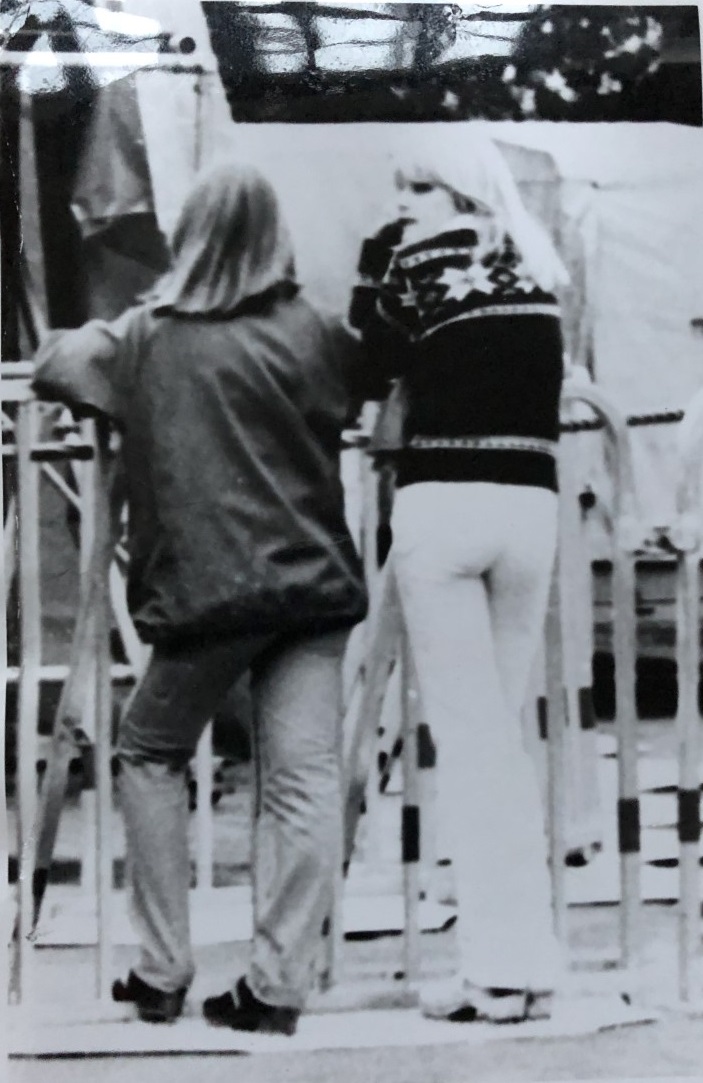 Outdoor shows has its merits. At least in the summer. The golden age of outdoor shows in Stockholm was in 1975-1977. I know, because I was there. The venue where it all took place was Gröna Lund, an amusement park(!). It's a relatively small park compared to other parks, mainly because of its central location, which effectively limits expansion. The scene area is also small. To name a few bands and artists who performed there in 1975-1977: Alice Cooper, Wishbone Ash, Status Quo, Uriah Heep, Kiss, The Sweet, Lou Reed, The Clash, Eagles and Thin Lizzy. The crappy photo on the left is taken by me on August 10, 1977. Later that night Thin Lizzy entered the stage. It was their second visit to Stockholm in less than a year. On September 30, 1976 they played at the Concert Hall. I had a ticket on the second row. The photo captures the fashion style at the time. Racoon make-up, swinging bangs, jeans (often white in the summer), wind jackets, folkloristic (synthetic) cardigans and, quite shocking, clogs (black or white). I saw a couple of shows in 1975-1977. However, I missed the british glam rock band The Sweet on May 5, 1976. They wrote history. Not only for cancelling two shows in a row (due to rain and risk of electrocution), but for the turmoil and disgust they created. They arrived at hotel Birger Jarl on May 3th after playing a show in Lund. Allegedly, a group of underaged girls were waiting outside the hotel to meet them. However, no indecent "meet and greet" occurred since neither underage girls or alcohol were allowed in the hotel rooms. The hotel was managed by the Mission Covenant Church of Sweden and they had a strict policy. Unsatisfied desires led to disappointment and hostility. Eventually, the staff threw them out. The editor of the magazine Poster (read more here, opens in a new window) intervened and tried to help them out. From a phone boot (yes, kids) he called virtually all hotels in Stockholm. Finally, they found refuge at hotel Malmen. You have to make hard prioirities when you are on a short-stay in Stockholm. The Sweet visited the dubious sex club Sexorama, known for live shows and naked women dangling in dusty nets over the tables, dim lightning and common despair. Things went from bad to worse before the show. During a soundcheck a couple of teenage girls slipped through the security and reached the scene area. This minor incident made guitarist Andy Scott very upset. He punched artist manager Ove Hahn in the face so hard that he fell into the tulip arrangements below the stage (yes, the same flower arrangements that Uriah Heep-singer David Byron fell into, read more here, opens in a new window). When the show was finished the sweet guys topped it off with smearing ketchup on the windows in the dressing room, urinating in the champagne coolers and, last but not least, handing over a turd in a folded tablecloth to manager Ove Hahn as a gift. Ove Hahn was a chastened man (when Jimi Hendrix played his set well overtime in 1967 he simply pulled out the power plug of the amplifier), but even he was shocked and appalled. "In my over 14 years as a manager, I have never experienced something so swinish". The band's manager David Walker tried to pour oil on troubled waters: "We are dealing with young, illiterate scoundrels who have become millionaires in a blink of an eye. They are not human beings, they are animals!". But the story doesn't end there. Legend has it that the band, not unexpectedly, received a complaint letter from Gröna Lund. The Sweet replied by sending a box with feces to the organizer. They were never booked again.
Outdoor shows has its merits. At least in the summer. The golden age of outdoor shows in Stockholm was in 1975-1977. I know, because I was there. The venue where it all took place was Gröna Lund, an amusement park(!). It's a relatively small park compared to other parks, mainly because of its central location, which effectively limits expansion. The scene area is also small. To name a few bands and artists who performed there in 1975-1977: Alice Cooper, Wishbone Ash, Status Quo, Uriah Heep, Kiss, The Sweet, Lou Reed, The Clash, Eagles and Thin Lizzy. The crappy photo on the left is taken by me on August 10, 1977. Later that night Thin Lizzy entered the stage. It was their second visit to Stockholm in less than a year. On September 30, 1976 they played at the Concert Hall. I had a ticket on the second row. The photo captures the fashion style at the time. Racoon make-up, swinging bangs, jeans (often white in the summer), wind jackets, folkloristic (synthetic) cardigans and, quite shocking, clogs (black or white). I saw a couple of shows in 1975-1977. However, I missed the british glam rock band The Sweet on May 5, 1976. They wrote history. Not only for cancelling two shows in a row (due to rain and risk of electrocution), but for the turmoil and disgust they created. They arrived at hotel Birger Jarl on May 3th after playing a show in Lund. Allegedly, a group of underaged girls were waiting outside the hotel to meet them. However, no indecent "meet and greet" occurred since neither underage girls or alcohol were allowed in the hotel rooms. The hotel was managed by the Mission Covenant Church of Sweden and they had a strict policy. Unsatisfied desires led to disappointment and hostility. Eventually, the staff threw them out. The editor of the magazine Poster (read more here, opens in a new window) intervened and tried to help them out. From a phone boot (yes, kids) he called virtually all hotels in Stockholm. Finally, they found refuge at hotel Malmen. You have to make hard prioirities when you are on a short-stay in Stockholm. The Sweet visited the dubious sex club Sexorama, known for live shows and naked women dangling in dusty nets over the tables, dim lightning and common despair. Things went from bad to worse before the show. During a soundcheck a couple of teenage girls slipped through the security and reached the scene area. This minor incident made guitarist Andy Scott very upset. He punched artist manager Ove Hahn in the face so hard that he fell into the tulip arrangements below the stage (yes, the same flower arrangements that Uriah Heep-singer David Byron fell into, read more here, opens in a new window). When the show was finished the sweet guys topped it off with smearing ketchup on the windows in the dressing room, urinating in the champagne coolers and, last but not least, handing over a turd in a folded tablecloth to manager Ove Hahn as a gift. Ove Hahn was a chastened man (when Jimi Hendrix played his set well overtime in 1967 he simply pulled out the power plug of the amplifier), but even he was shocked and appalled. "In my over 14 years as a manager, I have never experienced something so swinish". The band's manager David Walker tried to pour oil on troubled waters: "We are dealing with young, illiterate scoundrels who have become millionaires in a blink of an eye. They are not human beings, they are animals!". But the story doesn't end there. Legend has it that the band, not unexpectedly, received a complaint letter from Gröna Lund. The Sweet replied by sending a box with feces to the organizer. They were never booked again.
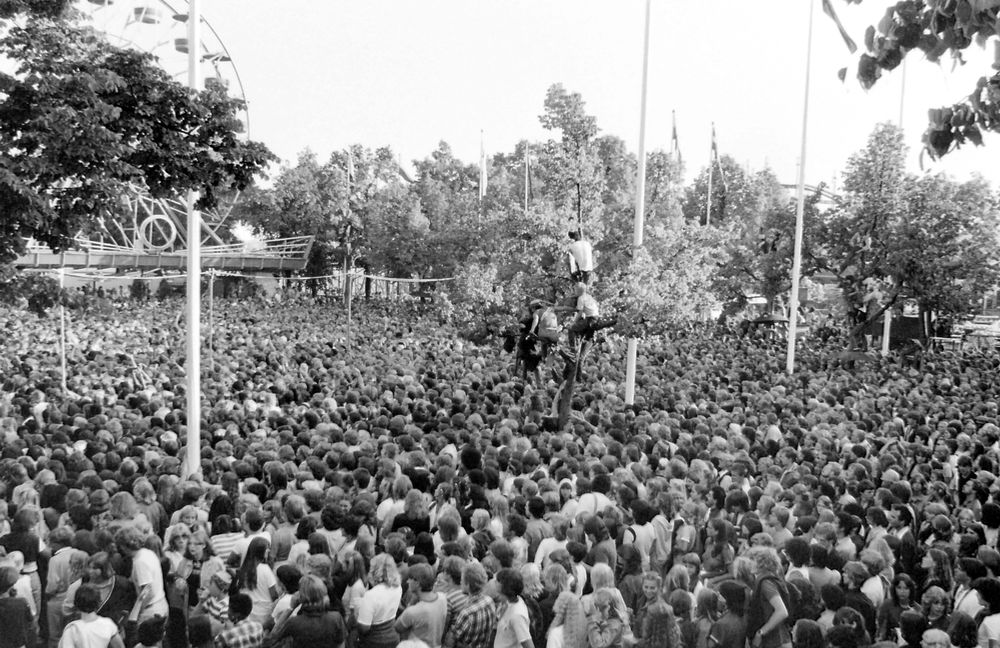 On June 17, 1980 Bob Marley performed at Gröna Lund for the fourth and last time (the Uprising Tour). Bob Marley was a superstar. He could have played at a larger venue, but wanted to come back to Gröna Lund who had booked him when he was an unknown artist. The hospitality rider included Malvern water, four liters (1 gallon) of pure fruit juice, a couple of Swiss quality cheeses, fresh bread, a couple of beers and two jars of jamaican honey. Allegedly, he was paid SEK 200 000 in cash. The attendance figure was estimated to 32 000 attendants. It still stands as the record for Gröna Lund (today's maximum is 17 000). In those days there was no such thing as prepaid tickets. It was be there or be square. People had waited for hours to get in and were desperate. Back in my time the bands brought their own PA system. The BMW loudspeakers were enormous, pumping out reggae basslines at unprecedent decibel levels. The soundcheck broke the floodgates. Some people climbed over the entrance gate. Others sneaked in from the rooftops of the adjacent residential area. People were everywhere to get a glimpse of BMW: in trees, clinging on to the Ferris wheel, on top of the carousels or on somebody's shoulder. Too many people in a small area could quickly turn into a disaster. Artist manager Ove Hahn understood this and acted. He grapped the microphone from one of the backing vocalists in the I-Threes and asked the audience, friendly but firm, to back a few steps to avoid people getting squeezed against the stage barrier. The crowd obediently stepped back. It was chaotic, but strangely enough nobody got seriously injured that night. Maybe the friendly atmosphere, the mesmerizing music or the marijuana smoke had a calming effect, or all of them in combination. Bob Marley was marked by cancer, but gave everything he got for almost two hours. The first song was "Natural Mystic" and the closing song was "Lively Up Yourself. The show became legendary and I'm very happy to have been a part of it. And the times were beginning to change. Not many people with racoon make-up or clogs. And, for what I can remember, no feces.
On June 17, 1980 Bob Marley performed at Gröna Lund for the fourth and last time (the Uprising Tour). Bob Marley was a superstar. He could have played at a larger venue, but wanted to come back to Gröna Lund who had booked him when he was an unknown artist. The hospitality rider included Malvern water, four liters (1 gallon) of pure fruit juice, a couple of Swiss quality cheeses, fresh bread, a couple of beers and two jars of jamaican honey. Allegedly, he was paid SEK 200 000 in cash. The attendance figure was estimated to 32 000 attendants. It still stands as the record for Gröna Lund (today's maximum is 17 000). In those days there was no such thing as prepaid tickets. It was be there or be square. People had waited for hours to get in and were desperate. Back in my time the bands brought their own PA system. The BMW loudspeakers were enormous, pumping out reggae basslines at unprecedent decibel levels. The soundcheck broke the floodgates. Some people climbed over the entrance gate. Others sneaked in from the rooftops of the adjacent residential area. People were everywhere to get a glimpse of BMW: in trees, clinging on to the Ferris wheel, on top of the carousels or on somebody's shoulder. Too many people in a small area could quickly turn into a disaster. Artist manager Ove Hahn understood this and acted. He grapped the microphone from one of the backing vocalists in the I-Threes and asked the audience, friendly but firm, to back a few steps to avoid people getting squeezed against the stage barrier. The crowd obediently stepped back. It was chaotic, but strangely enough nobody got seriously injured that night. Maybe the friendly atmosphere, the mesmerizing music or the marijuana smoke had a calming effect, or all of them in combination. Bob Marley was marked by cancer, but gave everything he got for almost two hours. The first song was "Natural Mystic" and the closing song was "Lively Up Yourself. The show became legendary and I'm very happy to have been a part of it. And the times were beginning to change. Not many people with racoon make-up or clogs. And, for what I can remember, no feces.
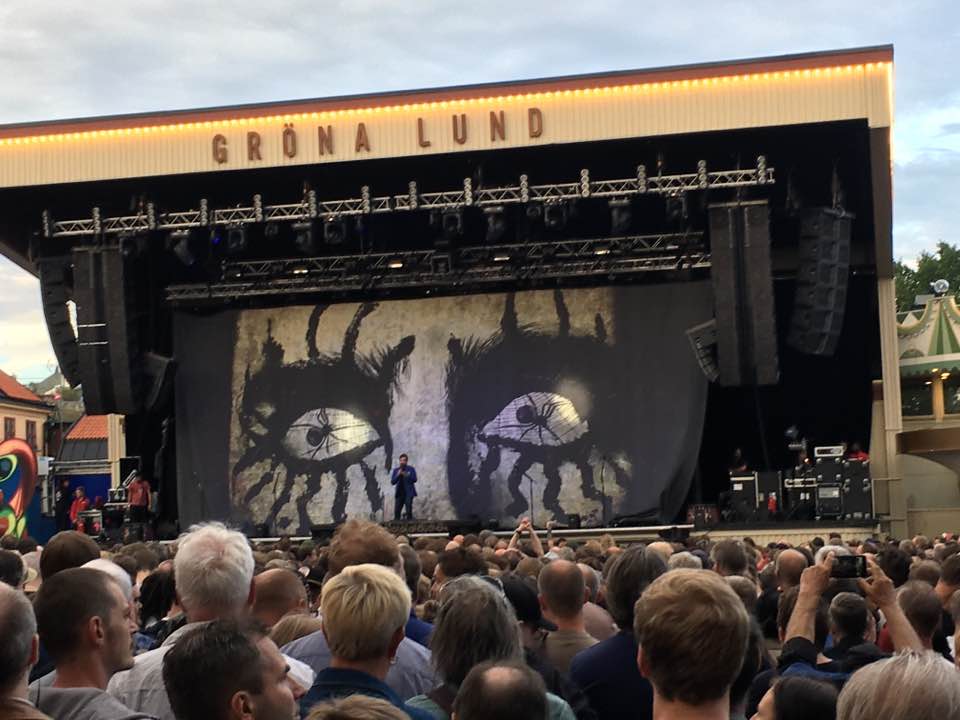 "Time is a flat circle. Everything we have done or will do we will do over and over and over again- forever". 40 years after the Thin Lizzy show I'm back at the very same place watching Alice Cooper and singing along with little or no credibility: "I'm eighteen / And I don't know what I want". Probably 80 percent of the audience were not even born in 1977. Apparently, Alice Cooper attracts all sorts of people from all sorts of places. You could hear accents that indicate a 300 km (200 miles) drive. Despite the guillotines and decapitations it was a family-friendly show in the bright summer night. And there were many more shows that summer. Gröna Lund has managed to nurture customer relations over the years and going there in the summer has become somewhat of a tradition for many people. One master stroke was to introduce season card. That summer you could see bands and artists like Megadeath, Elton John, Slayer and Patti Smith without paying anything extra. Some things are exactly the same. Like the smell of cotton candy, burgers and popcorn. But the circle of time isn't entirely flat. We don't end up precisely were we started. Some things aren't the same. Ove Hahn isn't around. He died in 2009. Ove Hahn was the artist manager between 1961-2000. That's committment, folks. I have also changed. With age comes less tolerance for crowding. In fact, I can't stand when people push me or try to walk right through me. No respect for elderly people anymore. And last, a major change. Not a single person with racoon make-up (except Alice Cooper) or clogs. And probably no feces.
"Time is a flat circle. Everything we have done or will do we will do over and over and over again- forever". 40 years after the Thin Lizzy show I'm back at the very same place watching Alice Cooper and singing along with little or no credibility: "I'm eighteen / And I don't know what I want". Probably 80 percent of the audience were not even born in 1977. Apparently, Alice Cooper attracts all sorts of people from all sorts of places. You could hear accents that indicate a 300 km (200 miles) drive. Despite the guillotines and decapitations it was a family-friendly show in the bright summer night. And there were many more shows that summer. Gröna Lund has managed to nurture customer relations over the years and going there in the summer has become somewhat of a tradition for many people. One master stroke was to introduce season card. That summer you could see bands and artists like Megadeath, Elton John, Slayer and Patti Smith without paying anything extra. Some things are exactly the same. Like the smell of cotton candy, burgers and popcorn. But the circle of time isn't entirely flat. We don't end up precisely were we started. Some things aren't the same. Ove Hahn isn't around. He died in 2009. Ove Hahn was the artist manager between 1961-2000. That's committment, folks. I have also changed. With age comes less tolerance for crowding. In fact, I can't stand when people push me or try to walk right through me. No respect for elderly people anymore. And last, a major change. Not a single person with racoon make-up (except Alice Cooper) or clogs. And probably no feces.
